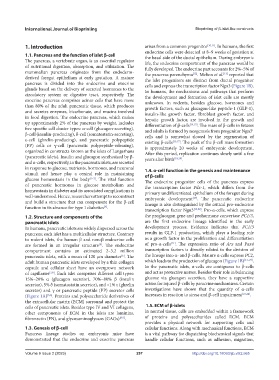Page 265 - IJB-9-2
P. 265
International Journal of Bioprinting Bioprinting of β-islet-like constructs
1. Introduction arises from a common progenitor [10,11] . In humans, the first
endocrine cells were detected at 8–9 weeks of gestation at
1.1. Pancreas and the function of islet β-cell the basal side of the ductal epithelium. During embryonic
The pancreas, a vertebrate organ, is an essential regulator life, the endocrine compartment of the pancreas would be
of nutritional digestion, absorption, and utilization. The fully developed. The endocrine part accounts for 2%–5% of
mammalian pancreas originates from the endoderm- the pancreas parenchyma . Melton et al. reported that
[13]
[12]
derived foregut epithelium at early gestation. A mature the islet progenitors are distinct from ductal progenitor
pancreas is divided into the endocrine and exocrine cells and express the transcription factor Ngn3 (Figure 1B).
glands based on the delivery of secreted hormones to the In humans, the mechanisms and pathways that perform
circulatory system or digestive tract, respectively. The the development and formation of islet cells are mostly
exocrine pancreas comprises acinar cells that have more unknown. In rodents, besides glucose, hormones and
than 80% of the adult pancreatic tissue, which produces growth factors, such as glucagon-like peptide-1 (GLP-1),
and secretes enzymes, bicarbonate, and mucins involved insulin-like growth factor, fibroblast growth factor, and
in food digestion. The endocrine pancreas, which makes hepatic growth factor, are involved in the growth and
up approximately 2% of the pancreas by weight, includes differentiation of β-cells [14,15] . The mass of β-cells in fetuses
five specific cell cluster types: α-cell (glucagon-secreting), and adults is formed by neogenesis from progenitor Ngn3
+
β-cell (insulin-producing), δ-cell (somatostatin-secreting), cells and is somewhat slowed by the regeneration of
ε-cell (ghrelin-producing), and pancreatic polypeptide existing β-cells [16,17] . The peak of the β-cell mass formation
(PP) cells or γ-cell (pancreatic polypeptide-releasing), is approximately 20 weeks of embryonic development.
organized in constructs known as the islets of Langerhans After this period, replication continues slowly until a few
(pancreatic islets). Insulin and glucagon synthesized by β- years after birth [18,19] .
and α-cells, respectively, in the pancreatic islets, are secreted
in response to glucose, nutrients, hormones, and neuronal 1.4. α-cell function in the genesis and maintenance
stimuli and hence play a central role in maintaining of β-cells
glucose homeostasis in the body [1–3] . The vital function The endocrine progenitor cells of the pancreas express
of pancreatic hormones in glucose metabolism and the transcription factor Pdx-1, which differs from the
homeostasis in diabetes and its associated complications is primary undifferentiated epithelium of the foregut during
well-understood. Hence, researchers attempt to reconstruct embryonic development . The pancreatic endocrine
[17]
and build a structure that can compensate for the β-cell lineage is also distinguished by the critical pro-endocrine
[4]
function in its absence for type 1 diabetics .
transcription factor Ngn3 [19,20] . Pro-α-cells, which express
1.2. Structure and components of the the proglucagon gene and prohormone convertase PC1/3,
pancreatic islets are the first endocrine lineage identified in the early
In humans, pancreatic islets are widely dispersed across the development process. Evidence indicates that PC1/3
pancreas; each islet has a multicellular structure. Contrary results in GLP-1 production, which plays a leading role
to rodent islets, the human β and non-β endocrine cells as a growth factor in the proliferation and differentiation
[21]
are formed in an irregular structure . The endocrine of pro-α-cells . The expression ratio of Arx and Pax4
[5]
compartment contains an estimated 2–3.2 million transcription factors is directly related to the division of
pancreatic islets, with a mean of 120 µm diameter . The the lineage into α- and β-cells. Mature α-cells express PC2,
[6]
adult human pancreatic islets enveloped by a thin collagen which leads to the production of glucagon (Figure 1B) [21–23] .
capsule and cellular sheet have an overgrown network In the pancreatic islets, α-cells are contiguous to β-cells
of capillaries [7,8] . Each islet comprises different cell types: and act as protective nurses. Besides their role in balancing
15%–20% α (glucagon secretor), 70%–80% β (insulin glucose via glucagon secretion, they have a supportive
secretor), 5% δ (somatostatin secretor), and <1% ε (ghrelin action for injured β-cells by paracrine mechanisms. Certain
secretor) and γ or pancreatic peptide (PP) secretor cells investigations have shown that the quantity of α-cells
(Figure 1A) [5,6] . Proteins and polysaccharide derivatives of increases in reaction to stress and β-cell impairment [23,24] .
the extracellular matrix (ECM) surround and protect the
cells of pancreatic islets. Besides type IV and VI collagens, 1.5. ECM of β-islets
other components of ECM in the islets are laminins, In normal tissue, cells are embedded within a framework
fibronectin (FN), and glycosaminoglycans (GAGs) [8,9] . of proteins and polysaccharides called ECM. ECM
provides a physical network for supporting cells and
1.3. Genesis of β-cell cellular functions. Along with mechanical functions, ECM
Pancreas lineage studies on embryonic mice have is a vital pathway for dispatching biochemical signals that
demonstrated that the endocrine and exocrine pancreas handle cellular functions, such as adhesion, migration,
Volume 9 Issue 2 (2023) 257 http://doi.org/10.18063/ijb.v9i2.665

